Short-Term and Long-Term Inhibitory Effects of Copper on Anammox Process †
Abstract
:1. Introduction
2. Material and Methods
2.1. Anammox Seed Sludge and Synthetic Wastewater
2.2. Experimental Setup Long-Term Experiment
2.3. Batch Studies
2.4. Analytical Methods
2.5. Evaluation of IC50 Values
- Modified non-competitive inhibition model
3. Results and Discussion
3.1. Short-Term Effect of Cu on Anammox
3.2. Long-Term Effect of Cu on Anammox
4. Conclusions
Author Contributions
Funding
Acknowledgments
Conflicts of Interest
References
- Larsdotter, K. Wastewater treatment with microalgae—A literature review. Vatten 2006, 62, 31–38. [Google Scholar]
- Zhu, G.; Peng, Y.; Li, B.; Guo, J.; Yang, Q.; Wang, S. Biological removal of nitrogen from wastewater. Rev. Environ. Contam. Toxicol. 2008, 192, 159–195. [Google Scholar] [CrossRef]
- Schmidt, I.; Sliekers, O.; Schmid, M.; Bock, E.; Fuerst, J.; Kuenen, J.G.; Jetten, M.S.M.; Strous, M. New concepts of microbial treatment processes for the nitrogen removal in wastewater. FEMS Microbiol. Rev. 2003, 27, 481–492. [Google Scholar] [CrossRef]
- Van der Star, W.R.L.; Abma, W.R.; Blommers, D.; Mulder, J.W.; Tokutomi, T.; Strous, M.; Picioreanu, C.; van Loosdrecht, M.C.M. Startup of reactors for anoxic ammonium oxidation: Experiences from the first full-scale anammox reactor in Rotterdam. Water Res. 2007, 41, 4149–4163. [Google Scholar] [CrossRef] [PubMed]
- Kartal, B.; Kuenen, J.G.; Van Loosdrecht, M.C.M. Sewage treatment with anammox. Science 2010, 328, 702–703. [Google Scholar] [CrossRef] [PubMed]
- Jetten, M.S.M.; Strous, M.; Van De Pas-Schoonen, K.T.; Schalk, J.; Van Dongen, U.G.J.M.; Van De Graaf, A.A.; Logemann, S.; Muyzer, G.; Van Loosdrecht, M.C.M.; Kuenen, J.G. The anaerobic oxidation of ammonium. FEMS Microbiol. Rev. 1998, 22, 421–437. [Google Scholar] [CrossRef] [PubMed]
- Strous, M.; Kuenen, J.G.; Fuerst, J.A.; Wagner, M.; Jetten, M.S.M. The anammox case—A new experimental manifesto for microbiological eco-physiology, Antonie van Leeuwenhoek. Int. J. Gen. Mol. Microbiol. 2002, 81, 693–702. [Google Scholar] [CrossRef]
- Imajo, U.; Tokutomi, T.; Furukawa, K. Granulation of Anammox microorganisms in up-flow reactors. Water Sci. Technol. 2004, 49, 155–163. [Google Scholar] [CrossRef] [PubMed]
- Isaka, K.; Date, Y.; Sumino, T.; Tsuneda, S. Ammonium removal performance of anaerobic ammonium- oxidizing bacteria immobilized in polyethylene glycol gel carrier: Anammox bacteria immobilized in gel carrier. Appl. Microbiol. Biotechnol. 2007, 76, 1457–1465. [Google Scholar] [CrossRef]
- Szatkowska, B.; Cema, G.; Plaza, E.; Trela, J.; Hultman, B. A one-stage system with partial nitritation and Anammox processes in the moving-bed biofilm reactor. Water Sci. Technol. 2007, 55, 19–26. [Google Scholar] [CrossRef]
- Aktan, C.K.; Yapsakli, K.; Mertoglu, B. Inhibitory effects of free ammonia on Anammox bacteria. Biodegradation 2012, 23, 751–762. [Google Scholar] [CrossRef]
- Strous, M.; Van Gerven, E.; Kuenen, J.G.; Jetten, M. Effects of aerobic and microaerobic conditions on anaerobic ammonium-oxidizing (Anammox) sludge. Appl. Environ. Microbiol. 1997, 63, 2446–2448. [Google Scholar] [CrossRef] [PubMed]
- Akgul, D.; Aktan, C.K.; Yapsakli, K.; Mertoglu, B. Treatment of landfill leachate using UASB-MBR- SHARON-Anammox configuration. Biodegradation 2013, 24, 399–412. [Google Scholar] [CrossRef]
- Egli, K.; Fanger, U.; Alvarez, P.J.J.; Siegrist, H.; Van der Meer, J.R.; Zehnder, A.J.B. Enrichment and characterization of an anammox bacterium from a rotating biological contactor treating ammonium-rich leachate. Arch. Microbiol. 2001, 175, 198–207. [Google Scholar] [CrossRef] [PubMed]
- Furukawa, K.; Inatomi, Y.; Qiao, S.; Quan, L.; Yamamoto, T.; Isaka, K.; Sumino, T. Innovative treatment system for digester liquor using anammox process. Bioresour. Technol. 2009, 100, 5437–5443. [Google Scholar] [CrossRef]
- Dapena-Mora, A.; Campos, J.L.; Mosquera-Corral, A.; Méndez, R. Anammox process for nitrogen removal from anaerobically digested fish canning effluents. Water Sci. Technol. 2006, 53, 265–274. [Google Scholar] [CrossRef] [PubMed]
- Tokutomi, T.; Yamauchi, H.; Nishimura, S.; Yoda, M.; Abma, W. Application of the Nitritation and Anammox Process into Inorganic Nitrogenous Wastewater from Semiconductor Factory. J. Environ. Eng. 2011, 137, 146–154. [Google Scholar] [CrossRef]
- Fux, C.; Marchesi, V.; Brunner, I.; Siegrist, H. Anaerobic ammonium oxidation of ammonium-rich waste streams in fixed-bed reactors. Water Sci. Technol. 2004, 49, 77–82. [Google Scholar] [CrossRef]
- Jin, R.C.; Yang, G.F.; Yu, J.J.; Zheng, P. The inhibition of the Anammox process: A review. Chem. Eng. J. 2012, 197, 67–79. [Google Scholar] [CrossRef]
- Tang, C.J.; Zheng, P.; Zhang, L.; Chen, J.W.; Mahmood, Q.; Chen, X.G.; Hu, B.L.; Wang, C.H.; Yu, Y. Enrichment features of anammox consortia from methanogenic granules loaded with high organic and methanol contents. Chemosphere 2010, 79, 613–619. [Google Scholar] [CrossRef]
- Dapena-Mora, A.; Fernández, I.; Campos, J.L.; Mosquera-Corral, A.; Méndez, R.; Jetten, M.S.M. Evaluation of activity and inhibition effects on Anammox process by batch tests based on the nitrogen gas production. Enzyme Microb. Technol. 2007, 40, 859–865. [Google Scholar] [CrossRef]
- Waki, M.; Tokutomi, T.; Yokoyama, H.; Tanaka, Y. Nitrogen removal from animal waste treatment water by anammox enrichment. Bioresour. Technol. 2007, 98, 2775–2780. [Google Scholar] [CrossRef]
- Fernández, I.; Vázquez-Padín, J.R.; Mosquera-Corral, A.; Campos, J.L.; Méndez, R. Biofilm and granular systems to improve Anammox biomass retention. Biochem. Eng. J. 2008, 42, 308–313. [Google Scholar] [CrossRef]
- Li, G.; Puyol, D.; Carvajal-Arroyo, J.M.; Sierra-Alvarez, R.; Field, J.A. Inhibition of anaerobic ammonium oxidation by heavy metals. J. Chem. Technol. Biotechnol. 2015, 90, 830–837. [Google Scholar] [CrossRef]
- Daverey, A.; Chen, Y.C.; Sung, S.; Lin, J.G. Effect of zinc on anammox activity and performance of simultaneous partial nitrification, anammox and denitrification (SNAD) process. Bioresour. Technol. 2014, 165, 105–110. [Google Scholar] [CrossRef]
- Yang, G.F.; Ni, W.M.; Wu, K.; Wang, H.; Yang, B.E.; Jia, X.Y.; Jin, R.C. The effect of Cu(II) stress on the activity, performance and recovery on the Anaerobic Ammonium-Oxidizing (Anammox) process. Chem. Eng. J. 2013, 226, 39–45. [Google Scholar] [CrossRef]
- Zhang, Z.Z.; Zhang, Q.Q.; Xu, J.J.; Deng, R.; Ji, Z.Q.; Wu, Y.H.; Jin, R.C. Evaluation of the inhibitory effects of heavy metals on anammox activity: A batch test study. Bioresour. Technol. 2016, 200, 208–216. [Google Scholar] [CrossRef] [PubMed]
- Zhang, Z.Z.; Deng, R.; Cheng, Y.F.; Zhou, Y.H.; Buayi, X.; Zhang, X.; Wang, H.Z.; Jin, R.C. Behavior and fate of copper ions in an anammox granular sludge reactor and strategies for remediation. J. Hazard. Mater. 2015, 300, 838–846. [Google Scholar] [CrossRef] [PubMed]
- Kjeldsen, P.; Barlaz, M.A.; Rooker, A.P.; Baun, A.; Ledin, A.; Christensen, T.H. Present and long-term composition of MSW landfill leachate: A review. Crit. Rev. Environ. Sci. Technol. 2002, 32, 297–336. [Google Scholar] [CrossRef]
- Kimura, Y.; Isaka, K. Evaluation of inhibitory effects of heavy metals on anaerobic ammonium oxidation (Anammox) by continuous feeding tests. Appl. Microbiol. Biotechnol. 2014, 98, 6965–6972. [Google Scholar] [CrossRef] [PubMed]
- Li, G.; Puyol, D.; Field, J.A. Inhibitory effect of heavy metals on nitrogen production by anaerobic ammonium oxidation bacteria. In Proceedings of the 13th World Congress on Anaerobic Digestion, Santiago de Compostela, Spain, 25–28 June 2013. [Google Scholar]
- Zhang, Z.Z.; Zhang, Q.Q.; Xu, J.J.; Shi, Z.J.; Guo, Q.; Jiang, X.Y.; Wang, H.Z.; Chen, G.H.; Jin, R.C. Long-term effects of heavy metals and antibiotics on granule-based anammox process: Granule property and performance evolution. Appl. Microbiol. Biotechnol. 2016, 100, 2417–2427. [Google Scholar] [CrossRef]
- Lotti, T.; Cordola, M.; Kleerebezem, R.; Caffaz, S.; Lubello, C.; Van Loosdrecht, M.C.M. Inhibition effect of swine wastewater heavy metals and antibiotics on anammox activity. Water Sci. Technol. 2012, 66, 1519–1526. [Google Scholar] [CrossRef] [PubMed]
- Bi, Z.; Qiao, S.; Zhou, J.; Tang, X.; Cheng, Y. Inhibition and recovery of Anammox biomass subjected to short-term exposure of Cd, Ag, Hg and Pb. Chem. Eng. J. 2014, 244, 89–96. [Google Scholar] [CrossRef]
- American Public Health Association (APHA); American Water Works Association (AWWA); World Economic Forum (WEF). Standard Methods for the Examination of Water and Wastewater; American Public Health Association: Washington, DC, USA, 2005; pp. 1–2671. [Google Scholar]
- Liang, Z.; Liu, J.X.; Li, J. Decomposition and mineralization of aquatic humic substances (AHS) in treating landfill leachate using the Anammox process. Chemosphere 2009, 74, 1315–1320. [Google Scholar] [CrossRef] [PubMed]
- Hu, Z.; Chandran, K.; Grasso, D.; Smets, B.F. Effect of nickel and cadmium speciation on nitrification inhibition. Environ. Sci. Technol. 2002, 36, 3074–3078. [Google Scholar] [CrossRef]
- Val del Río, Á.; da Silva, T.; Martins, T.; Foresti, E.; Campos, J.L.; Méndez, R.; Mosquera-Corral, A. Partial Nitritation-Anammox Granules: Short-Term Inhibitory Effects of Seven Metals on Anammox Activity. Water Air Soil Pollut. 2017, 228, 439. [Google Scholar] [CrossRef]
- Chen, H.; Yu, J.J.; Jia, X.Y.; Jin, R.C. Enhancement of anammox performance by Cu(II), Ni(II) and Fe(III) supplementation. Chemosphere 2014, 117, 610–616. [Google Scholar] [CrossRef] [PubMed]
- Zhang, Q.Q.; Zhang, Z.Z.; Guo, Q.; Chen, Q.Q.; Jin, R.C.; Jia, X.Y. Variation in the performance and sludge characteristics of anaerobic ammonium oxidation inhibited by copper. Sep. Purif. Technol. 2015, 142, 108–115. [Google Scholar] [CrossRef]
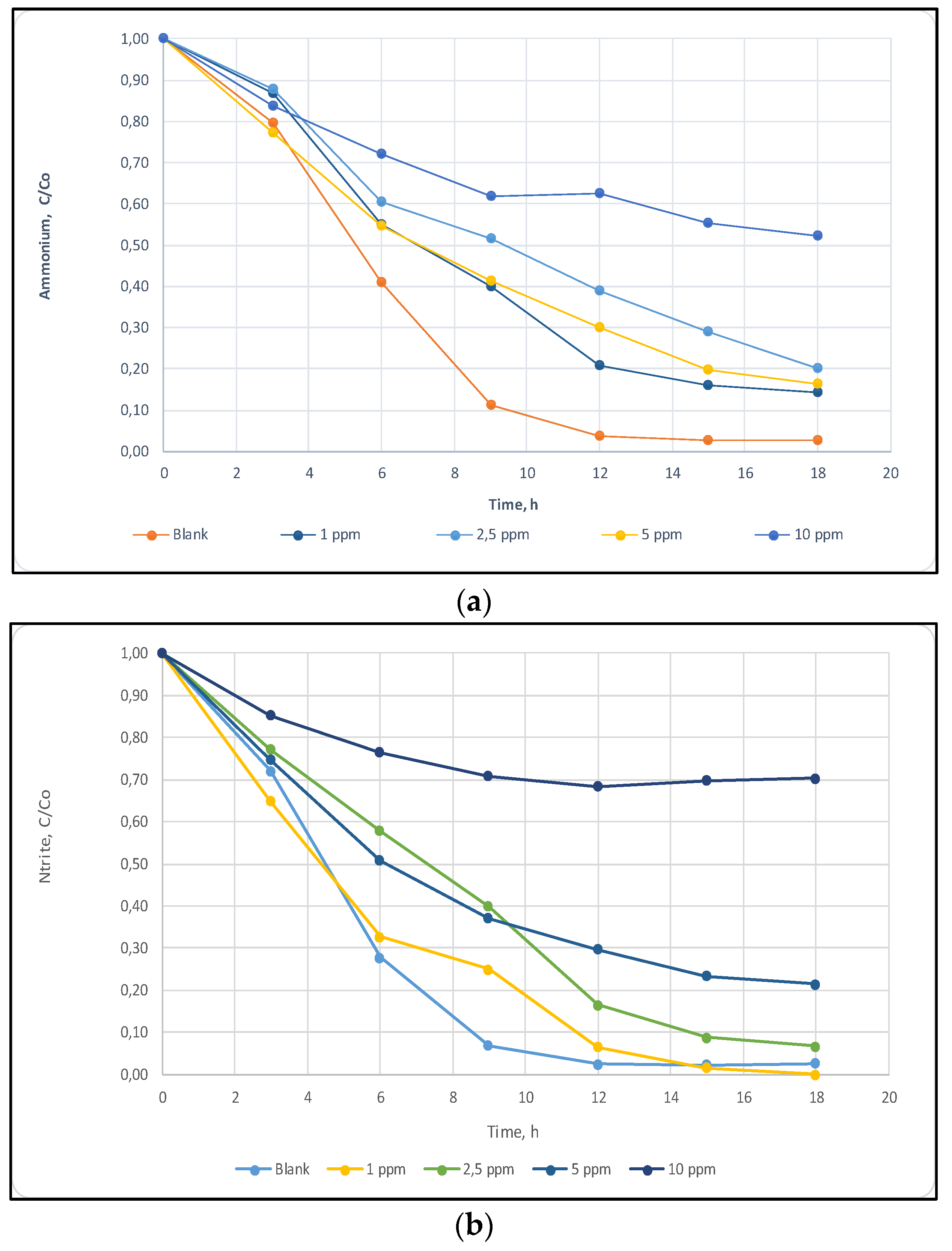
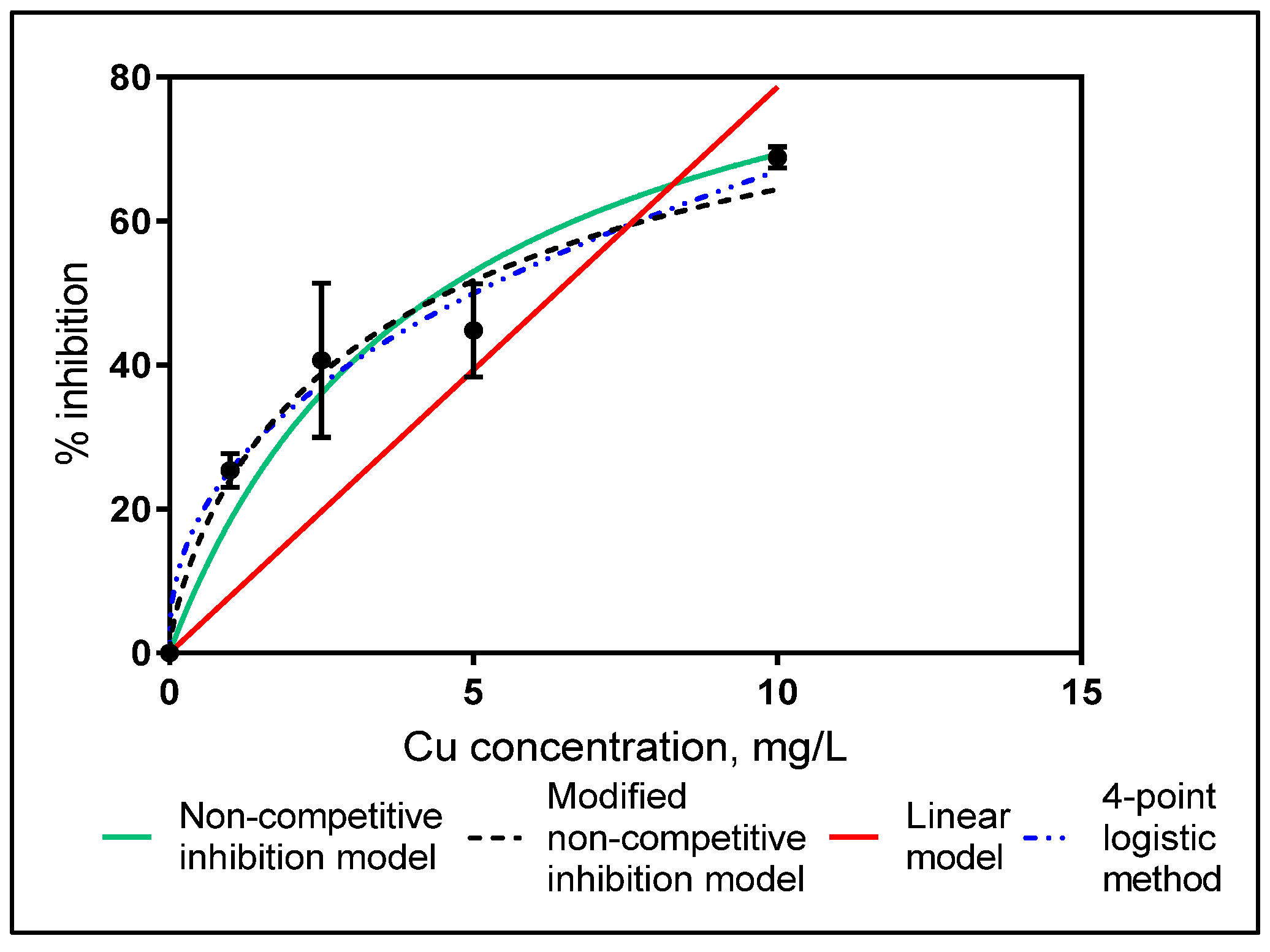
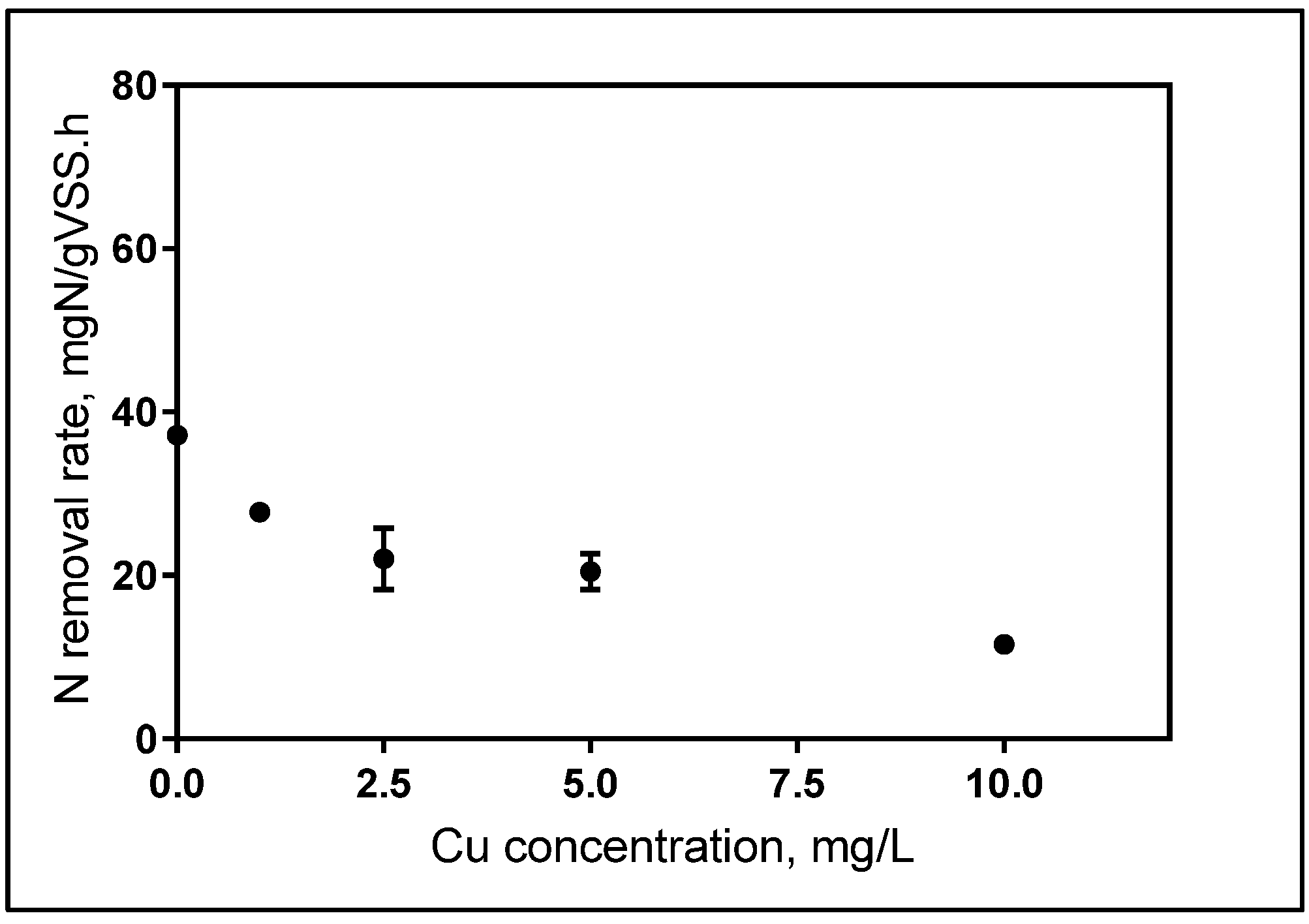
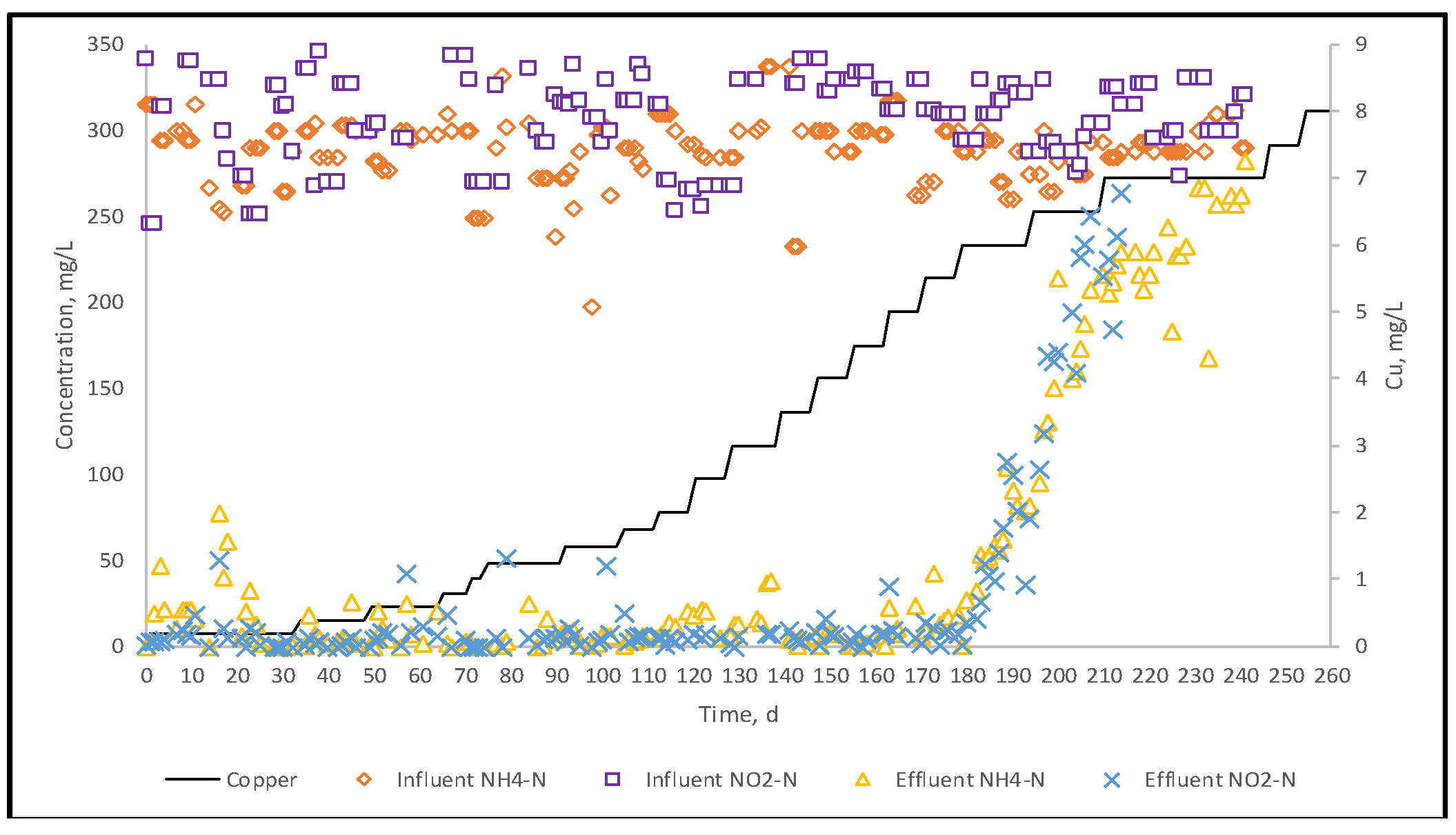
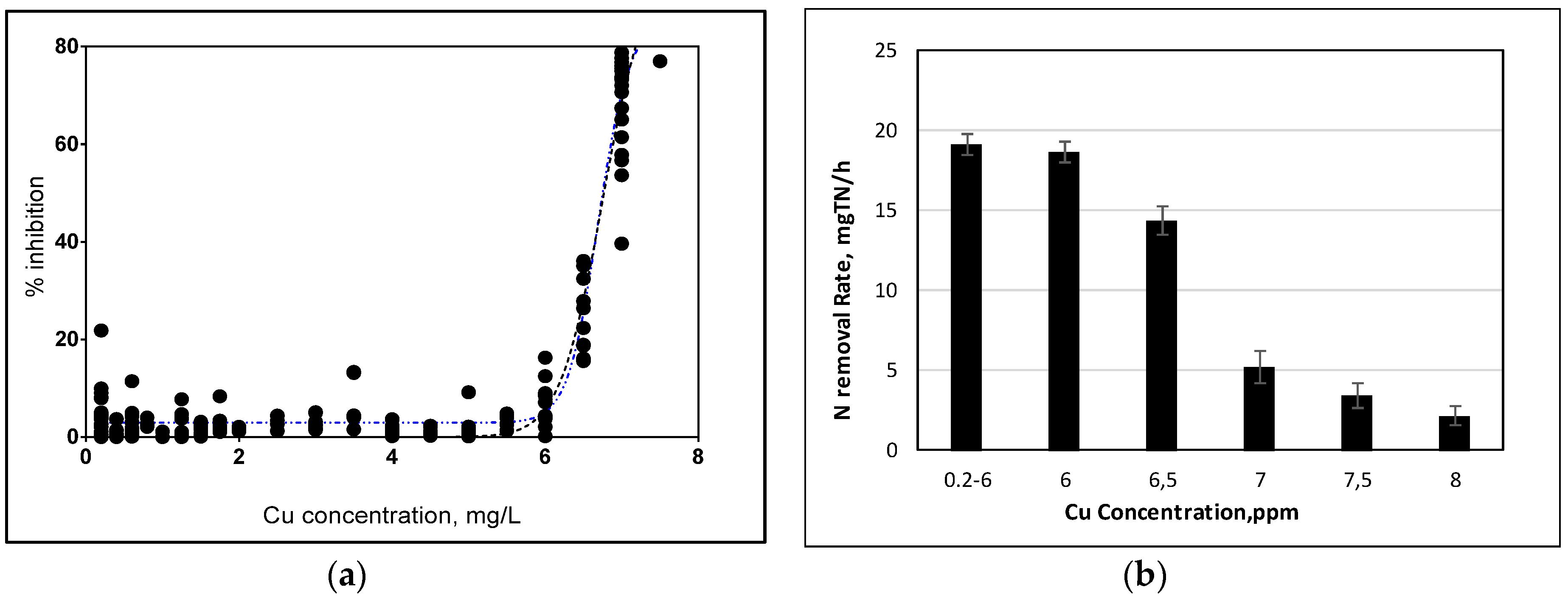
Publisher’s Note: MDPI stays neutral with regard to jurisdictional claims in published maps and institutional affiliations. |
© 2018 by the authors. Licensee MDPI, Basel, Switzerland. This article is an open access article distributed under the terms and conditions of the Creative Commons Attribution (CC BY) license (https://creativecommons.org/licenses/by/4.0/).
Share and Cite
Aktan, C.K.; Uzunhasanoglu, A.E.; Yapsakli, K.; Mertoglu, B. Short-Term and Long-Term Inhibitory Effects of Copper on Anammox Process. Proceedings 2018, 2, 657. https://doi.org/10.3390/proceedings2110657
Aktan CK, Uzunhasanoglu AE, Yapsakli K, Mertoglu B. Short-Term and Long-Term Inhibitory Effects of Copper on Anammox Process. Proceedings. 2018; 2(11):657. https://doi.org/10.3390/proceedings2110657
Chicago/Turabian StyleAktan, Cigdem Kalkan, Ayse Ekin Uzunhasanoglu, Kozet Yapsakli, and Bulent Mertoglu. 2018. "Short-Term and Long-Term Inhibitory Effects of Copper on Anammox Process" Proceedings 2, no. 11: 657. https://doi.org/10.3390/proceedings2110657
APA StyleAktan, C. K., Uzunhasanoglu, A. E., Yapsakli, K., & Mertoglu, B. (2018). Short-Term and Long-Term Inhibitory Effects of Copper on Anammox Process. Proceedings, 2(11), 657. https://doi.org/10.3390/proceedings2110657




